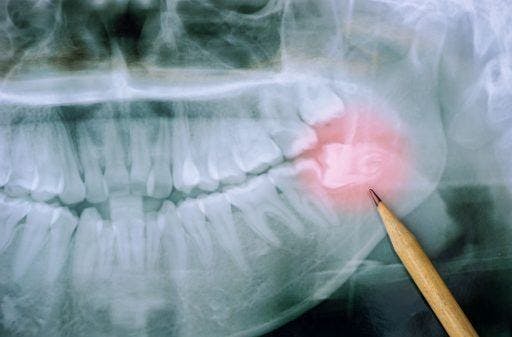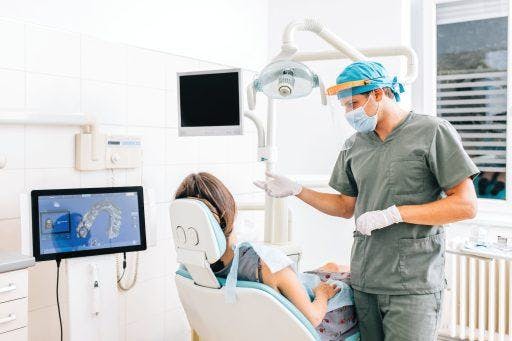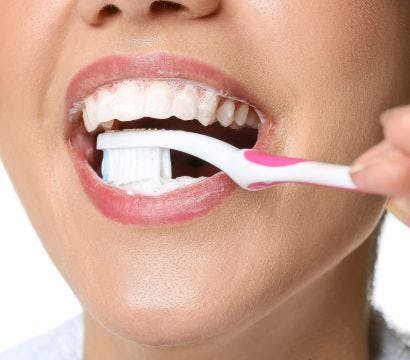Some cultures believe that wisdom teeth are a sign of good fortune, intelligence, or maturity. That’s all well and good, but luck can’t ward off an impacted tooth, most cases of which are hereditary.
An impacted tooth can happen even at a young age, like when a baby tooth makes way for a permanent one. Sometimes it doesn’t even come with discomfort or pain. Is it better to leave it alone if that’s the case? How does tooth impaction happen in the first place? And what are the signs apart from pain? Find the answers below.
What is an impacted tooth?
Teeth development works on a schedule. First, the milk teeth emerge (or erupt in dental terms) at six months old. Then, the baby teeth shed as the permanent teeth come in around age six. By age 21, a full set of adult teeth will amount to 32 teeth in total (or 28 after wisdom teeth extraction). This includes incisors, canines, premolars, molars, and wisdom teeth.
A tooth becomes impacted when it doesn’t or cannot erupt at the expected time. Instead, it grows in the wrong direction, horizontally or vertically and too close to another tooth. It can also come out at an angle, trapped in the gum or pushing the tooth beside it.
Causes of tooth impaction
The exact cause of tooth impaction remains unknown. Genetics can play a role – it can happen to you if your parents have it. But the topic still needs extensive research to pinpoint the exact cause.
Apart from genetic predisposition, dentists consider dental crowding another risk factor since it leaves no room for new teeth to emerge or erupt. Overcrowding can happen with a small jaw or when the jaw stops developing right when the teeth are due to appear.
Children may develop an impacted tooth when a permanent tooth becomes trapped within the gum tissue. One common cause, says the American Association of Orthodontists, is the delayed loss of a baby tooth, which prevents the permanent tooth from emerging.
Obstructions such as cysts can also impede the path of the permanent tooth, which becomes trapped in the gum.
Signs of an impacted tooth

In most cases, impacted teeth have no symptoms, and dentists discover them during routine X-rays. However, neighbouring teeth can suffer damage to their roots when a permanent tooth fails to erupt entirely or comes up in the wrong direction. Or impacted teeth can cause already erupted teeth to shift into unhealthy alignments.
These conditions can lead to tooth sensitivity and risks of tooth decay and gum disease without treatment. Signs of an impacted tooth to look out for:
- Difficulty opening the mouth
- Pain or tenderness on the gums
- Redness and swelling of the gums
- Difficulty swallowing
- Bad breath
If it’s an impacted third molar, you may notice the following:
- Sore and red gums
- Persistent pain and bleeding in the mouth
- Difficulty opening the mouth
- Breathing challenges
You can check your children for impacted teeth by paying close attention to their teeth on both sides of the mouth. For example, there might be an impaction if a tooth on one side of the mouth has fallen out, but the other tooth on the opposite side shows no signs of budging.
Which teeth are most often impacted?
According to an Oral and Maxillofacial Surgery Clinics of North America study, lower wisdom teeth, or third molars at the back of the mouth, are the most frequently impacted. Upper wisdom teeth rank second, followed by upper canines, lower premolars, and upper incisors.
Complications of an impacted tooth
If left untreated, an impacted tooth can lead to the following:
- Gum disease
- Infection
- Oral abscess
- Chronic oral discomfort
- Trapped plaque
Treatment options for an impacted tooth
Many people discover they have an impacted tooth when they visit the dentist for pain. At this stage, a dentist may suggest tooth extraction, particularly for an impacted wisdom tooth. The operation may take an hour, with recovery up to 10 days, depending on the severity of the condition.
Some cases require what dental health professionals call “eruption aids”, also known as pontics. These may include brackets, metal braces, or invisible aligners like ClearCorrect. Dentists typically prescribe eruption aids for younger patients whose teeth need a little help to erupt (i.e., forced eruption through a pontic site). However, the dentist must remove the tooth if it still becomes impacted.
Is it okay to leave an impacted tooth?

You shouldn’t ignore the impacted tooth because of the lack of pain. Your dentist must monitor it to prevent cavities, tooth abscesses, and gum disease.
How serious is an impacted tooth? Some cases of impacted teeth can lead to a dentigerous cyst. This sac develops when fluid accumulates between the impacted tooth‘s crown and the outer layer of enamel. The cyst may not cause pain until it becomes infected and requires surgery.
Since an impacted tooth can push others out of position, it can affect how the upper and lower rows fit together. It can cause teeth misalignment or malocclusion, such as an open bite or a lateral crossbite. These can cause changes in facial appearance and affect your self-confidence. Take this online smile assessment to find out if you’re dealing with such issues.
Pain shouldn’t be a sign of going to the dentist. Dental checkups provide timely dental care and preventive measures to fend off trouble. Regular dental visits also allow for professional cleanings that keep your teeth and gums in optimal condition.
Don’t wait for the symptoms of an impacted tooth to escalate or interfere with your quality of life. Instead, take control of your dental well-being by scheduling regular dentist appointments. Invest in your oral health today for a radiant smile tomorrow.
References:
Allareddy, V., Caplin, J., Markiewicz, M. R., & Meara, D. J. (2020). Orthodontic and surgical considerations for treating impacted teeth. Oral and Maxillofacial Surgery Clinics of North America, 32(1), 15–26.
Baum, A. (2022). What Is An Impacted Tooth? American Association of Orthodontists.
Deepa, K., Jannu, A., Kulambi, M., & Shalini, H. S. (2021). A case of dentigerous cyst in a pediatric patient – With an insight into differential diagnostic entities. Advances in Oral and Maxillofacial Surgery, 3, 100130.
Malocclusion of teeth: MedlinePlus Medical Encyclopedia. (n.d.).
Ullah, M., Irshad, M., Yaacoub, A., Carter, E., Thorpe, A., Zoellner, H., & Cox, S. (2023). Dental Infection Requiring Hospitalisation Is a Public Health Problem in Australia: A Systemic Review Demonstrating an Urgent Need for Published Data. Dentistry Journal, 11(4), 97.



